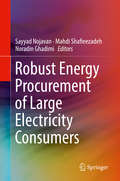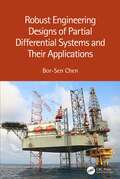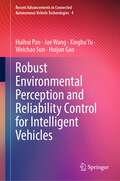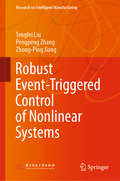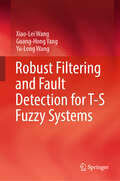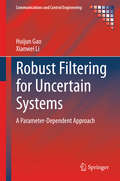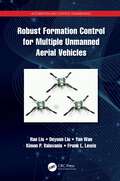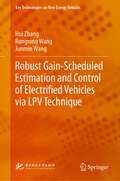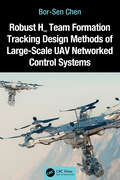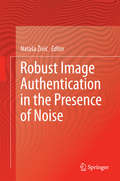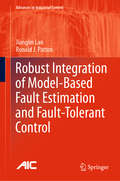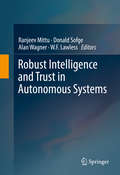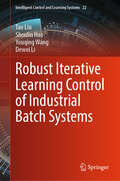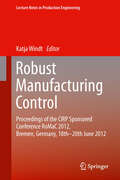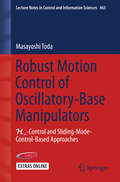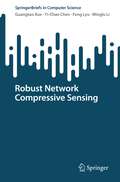- Table View
- List View
Robust Energy Procurement of Large Electricity Consumers
by Sayyad Nojavan Mahdi Shafieezadeh Noradin GhadimiThis book identifies the challenges faced by large electricity consumers when they use several sources to procure their energy. The huge penetration of distributed energy resources and the intermittent nature of renewables can put the operations of the large electricity consumer at risk. The book discusses the different types of energy sources including the pool market, bilateral contracts, electrical vehicles, energy storage systems, and demand response programs in detail and presents solutions for robust and risk based scheduling. The author provides models for determining and considering uncertainties and optimal bidding strategies. The book is useful to engineers and students involved in the integration of various energy types as well as those working in state and federal governmental organizations who regulate different aspects of electricity market operation and planning.Presents solutions for robust and risk based scheduling;Discusses the operation and planning of energy storage systems;Presents the most-up-to-date technological approaches to energy integration.
Robust Engineering Designs of Partial Differential Systems and Their Applications
by Bor-Sen ChenMost systems in science, engineering, and biology are of partial differential systems (PDSs) modeled by partial differential equations. Many books about partial differential equations have been written by mathematicians and mainly address some fundamental mathematic backgrounds and discuss some mathematic properties of partial differential equations. Only a few books on PDSs have been written by engineers; however, these books have focused mainly on the theoretical stabilization analysis of PDSs, especially mechanical systems. This book investigates both robust stabilization control design and robust filter design and reference tracking control design in mechanical, signal processing, and control systems to fill a gap in the study of PDSs. Robust Engineering Designs of Partial Differential Systems and Their Applications offers some fundamental background in the first two chapters. The rest of the chapters focus on a specific design topic with a corresponding deep investigation into robust H∞ filtering, stabilization, or tracking design for more complex and practical PDSs under stochastic fluctuation and external disturbance. This book is aimed at engineers and scientists and addresses the gap between the theoretical stabilization results of PDSs in academic and practical engineering designs more focused on the robust H∞ filtering, stabilization, and tracking control problems of linear and nonlinear PDSs under intrinsic random fluctuation and external disturbance in industrial applications. Part I provides backgrounds on PDSs, such as Galerkin’s, and finite difference methods to approximate PDSs and a fuzzy method to approximate nonlinear PDSs. Part II examines robust H∞ filter designs for the robust state estimation of linear and nonlinear stochastic PDSs. And Part III treats robust H∞ stabilization and tracking control designs of linear and nonlinear PDSs. Every chapter focuses on an engineering design topic with both theoretical design analysis and practical design examples.
Robust Environmental Perception and Reliability Control for Intelligent Vehicles (Recent Advancements in Connected Autonomous Vehicle Technologies #4)
by Huijun Gao Weichao Sun Jue Wang Xinghu Yu Huihui PanThis book presents the most recent state-of-the-art algorithms on robust environmental perception and reliability control for intelligent vehicle systems. By integrating object detection, semantic segmentation, trajectory prediction, multi-object tracking, multi-sensor fusion, and reliability control in a systematic way, this book is aimed at guaranteeing that intelligent vehicles can run safely in complex road traffic scenes.Adopts the multi-sensor data fusion-based neural networks to environmental perception fault tolerance algorithms, solving the problem of perception reliability when some sensors fail by using data redundancy.Presents the camera-based monocular approach to implement the robust perception tasks, which introduces sequential feature association and depth hint augmentation, and introduces seven adaptive methods.Proposes efficient and robust semantic segmentation of traffic scenes through real-time deep dual-resolution networks and representation separation of vision transformers.Focuses on trajectory prediction and proposes phased and progressive trajectory prediction methods that is more consistent with human psychological characteristics, which is able to take both social interactions and personal intentions into account.Puts forward methods based on conditional random field and multi-task segmentation learning to solve the robust multi-object tracking problem for environment perception in autonomous vehicle scenarios. Presents the novel reliability control strategies of intelligent vehicles to optimize the dynamic tracking performance and investigates the completely unknown autonomous vehicle tracking issues with actuator faults.
Robust Event-Triggered Control of Nonlinear Systems: Theory And Applications (Research on Intelligent Manufacturing)
by Zhong-Ping Jiang Tengfei Liu Pengpeng ZhangThis book presents a study on the novel concept of "event-triggered control of nonlinear systems subject to disturbances", discussing the theory and practical applications. Richly illustrated, it is a valuable resource for researchers, engineers and graduate students in automation engineering who wish to learn the theories, technologies, and applications of event-triggered control of nonlinear systems.
Robust Filtering and Fault Detection for T-S Fuzzy Systems
by Xiao-Lei Wang Guang-Hong Yang Yu-Long WangThis book conducts an in-depth research on robust filtering and fault detection for a class of T-S fuzzy systems. On the basis of the existing research on T-S fuzzy theory, robust filtering theory, and fault diagnosis theory, some new and effective technologies are proposed to solve the problems of robust filtering and fault detection for a class T-S fuzzy systems, while overcoming the shortcomings and limitations of the existing solutions. This book introduces new design solutions for a class of T-S fuzzy systems to address the existing problems in the research of robust filtering and fault detection, namely 1) two new filtering methods are explored to obtain better filtering results than the existing approaches; 2) a new event-triggered filtering scheme is proposed for T-S fuzzy systems with bounded disturbances, which realizes that the designed observer gains in the absence of event-triggered mechanisms are also applicable to the case with event-triggered mechanisms; 3) two new methods are constructed to deal with the asynchronous problems of premise variables effectively, which overcome the defects and limitations of the existing ones; and 4) an effective fault detection scheme for handling measurement outliers is constructed, which can avoid the occurrence of false alarms. This book is intended to inspire researchers and engineers, offering deeper insights into robust filtering and fault detection for T-S fuzzy systems, and equipping them with the latest advancements in fuzzy system theory, robust filtering, and fault diagnosis. It also provides valuable theoretical references for engineers tackling practical engineering problems.
Robust Filtering for Uncertain Systems
by Huijun Gao Xianwei LiThis monograph provides the reader with a systematic treatment of robust filter design, a key issue in systems, control and signal processing, because of the fact that the inevitable presence of uncertainty in system and signal models often degrades the filtering performance and may even cause instability. The methods described are therefore not subject to the rigorous assumptions of traditional Kalman filtering. The monograph is concerned with robust filtering for various dynamical systems with parametric uncertainties and focuses on parameter-dependent approaches to filter design. Classical filtering schemes, like H2 filtering and H¥ filtering, are addressed and emerging issues such as robust filtering with constraints on communication channels and signal frequency characteristics are discussed. The text features: · design approaches to robust filters arranged according to varying complexity level and emphasizing robust filtering in the parameter-dependent framework for the first time; · guidance on the use of special realistic phenomena or factors to describe problems more accurately and to improve filtering performance; · a unified linear matrix inequality formulation of design approaches for easy and effective filter design; · demonstration of the techniques of matrix decoupling technique, the generalized Kalmanâe'Yakubovichâe'Popov lemma, the free weighting matrix technique and the delay modelling approach, in robust filtering; · numerous easy-to-follow simulation examples, graphical and tabular illustrations to help the reader understand the filter design approaches developed; and · an account of emerging issues on robust filtering for research to inspire future investigation. Robust Filtering for Uncertain Systems will be of interest to academic researchers specializing in linear, robust and optimal control and estimation and to practitioners working in tracking and network control or signal filtering, detection and estimation. Graduate students learning control and systems theory, signal processing or applied mathematics will also find the book to be a valuable resource.
Robust Formation Control for Multiple Unmanned Aerial Vehicles (ISSN)
by Frank Lewis Hao Liu Yan Wan Deyuan Liu Kimon ValavanisThis book is based on the authors’ recent research results on formation control problems, including time-varying formation, communication delays, fault-tolerant formation for multiple UAV systems with highly nonlinear and coupled, parameter uncertainties, and external disturbances. Differentiating from existing works, this book presents a robust optimal formation approach to designing distributed cooperative control laws for a group of UAVs, based on the linear quadratic regulator control method and the robust compensation theory. The proposed control method is composed of two parts: the nominal part to achieve desired tracking performance and the robust compensation part to restrain the influence of highly nonlinear and strongly coupled parameter uncertainties, and external disturbances on the global closed-loop control system. Furthermore, this book gives proof of their robust properties. The influence of communication delays and actuator fault tolerance can be restrained by the proposed robust formation control protocol, and the formation tracking errors can converge into a neighborhood of the origin bounded by a given constant in a finite time. Moreover, the book provides details about the practical application of the proposed method to design formation control systems for multiple quadrotors and tail-sitters. Additional features include a robust control method that is proposed to address the formation control problem for UAVs and theoretical and experimental research for the cooperative flight of the quadrotor UAV group and the tail-sitter UAV group. Robust Formation Control for Multiple Unmanned Aerial Vehicles is suitable for graduate students, researchers, and engineers in the system and control community, especially those engaged in the areas of robust control, UAV swarming, and multi-agent systems.
Robust Gain-Scheduled Estimation and Control of Electrified Vehicles via LPV Technique (Key Technologies on New Energy Vehicles)
by Hui Zhang Junmin Wang Rongrong WangThis book presents techniques such as the robust control and nonlinearity approximation using linear-parameter-varying (LPV) techniques. Meanwhile, the control of independently driven electric vehicles and autonomous vehicles is introduced. It covers a comprehensive literature review, robust state estimation with uncertain measurements, sideslip angle estimation with finite-frequency optimization, fault detection of vehicle steering systems, output-feedback control of in-wheel motor-driven electric vehicles, robust path following control with network-induced issues, and lateral motion control with the consideration of actuator saturation. This book is a good reference for researchers and engineers working on control of electric vehicles.
Robust H∞ Team Formation Tracking Design Methods of Large-Scale UAV Networked Control Systems
by Bor-Sen ChenThis book introduces the centralized robust H∞ team formation tracking control strategy of multi-unmanned aerial vehicle (multi-UAV) network system under intrinsic random fluctuation, time-varying delay and packet dropout in wireless communication, and external disturbance. A simple robust decentralized H∞ proportional-integral-derivative (PID) reference tracking network control strategy is introduced for practical applications of team formation of large-scale UAV under control saturation constraint, external disturbance, and vortex coupling. It provides practical design procedures based on linear matrix inequalities (LMIs) solvable via LMI TOOLBOX in MATLAB®. Features: Focuses on the stabilization of a QUAV under finite-time switching model control (SMC) Discusses robustness control design for formation tracking in UAV networks Introduces different robust centralized and decentralized H∞ attack-tolerant observer-based reference team formation tracking control of large-scale UAVs Reviews practical case studies in each chapter to introduce the design procedures Includes design examples of team formation of 25 quadrotor UAVs and a team formation example of five hybrid quadrotor/biped robot sub-teams This book is aimed at researchers and graduate students in control and electrical engineering.
Robust Image Authentication in the Presence of Noise
by Nataša ŽivićThis book addresses the problems that hinder image authentication in the presence of noise. It considers the advantages and disadvantages of existing algorithms for image authentication and shows new approaches and solutions for robust image authentication. The state of the art algorithms are compared and, furthermore, innovative approaches and algorithms are introduced. The introduced algorithms are applied to improve image authentication, watermarking and biometry. Aside from presenting new directions and algorithms for robust image authentication in the presence of noise, as well as image correction, this book also: Provides an overview of the state of the art algorithms for image authentication in the presence of noise and modifications, as well as a comparison of these algorithms, Presents novel algorithms for robust image authentication, whereby the image is tried to be corrected and authenticated, Examines different views for the solution of problems connected to image authentication in the presence of noise, Shows examples, how the new techniques can be applied to image authentication, watermarking and biometry. This book is written on the one hand for students, who want to learn about image processing, authentication, watermarking and biometry, and on the other hand for engineers and researchers, who work on aspects of robustness against modifications of secure images.
Robust Integration of Model-Based Fault Estimation and Fault-Tolerant Control (Advances in Industrial Control)
by Jianglin Lan Ronald J. PattonRobust Integration of Model-Based Fault Estimation and Fault-Tolerant Control is a systematic examination of methods used to overcome the inevitable system uncertainties arising when a fault estimation (FE) function and a fault-tolerant controller interact as they are employed together to compensate for system faults and maintain robustly acceptable system performance. It covers the important subject of robust integration of FE and FTC with the aim of guaranteeing closed-loop stability. The reader’s understanding of the theory is supported by the extensive use of tutorial examples, including some MATLAB®-based material available from the Springer website and by industrial-applications-based material. The text is structured into three parts:Part I examines the basic concepts of FE and FTC, providing extensive insight into the importance of and challenges involved in their integration;Part II describes five effective strategies for the integration of FE and FTC: sequential, iterative, simultaneous, adaptive-decoupling, and robust decoupling; andPart III begins to extend the proposed strategies to nonlinear and large-scale systems and covers their application in the fields of renewable energy, robotics and networked systems. The strategies presented are applicable to a broad range of control problems, because in the absence of faults the FE-based FTC naturally reverts to conventional observer-based control. The book is a useful resource for researchers and engineers working in the area of fault-tolerant control systems, and supplementary material for a graduate- or postgraduate-level course on fault diagnosis and FTC.Advances in Industrial Control reports and encourages the transfer of technology in control engineering. The rapid development of control technology has an impact on all areas of the control discipline. The series offers an opportunity for researchers to present an extended exposition of new work in all aspects of industrial control.
Robust Intelligence and Trust in Autonomous Systems
by Ranjeev Mittu Donald Sofge Alan Wagner W. F. LawlessThis volume explores the intersection of robust intelligence (RI) and trust in autonomous systems across multiple contexts among autonomous hybrid systems, where hybrids are arbitrary combinations of humans, machines and robots. To better understand the relationships between artificial intelligence (AI) and RI in a way that promotes trust between autonomous systems and human users, this book explores the underlying theory, mathematics, computational models, and field applications. It uniquely unifies the fields of RI and trust and frames it in a broader context, namely the effective integration of human-autonomous systems. A description of the current state of the art in RI and trust introduces the research work in this area. With this foundation, the chapters further elaborate on key research areas and gaps that are at the heart of effective human-systems integration, including workload management, human computer interfaces, team integration and performance, advanced analytics, behavior modeling, training, and, lastly, test and evaluation. Written by international leading researchers from across the field of autonomous systems research, Robust Intelligence and Trust in Autonomous Systems dedicates itself to thoroughly examining the challenges and trends of systems that exhibit RI, the fundamental implications of RI in developing trusted relationships with present and future autonomous systems, and the effective human systems integration that must result for trust to be sustained. Contributing authors: David W. Aha, Jenny Burke, Joseph Coyne, M. L. Cummings, Munjal Desai, Michael Drinkwater, Jill L. Drury, Michael W. Floyd, Fei Gao, Vladimir Gontar, Ayanna M. Howard, Mo Jamshidi, W. F. Lawless, Kapil Madathil, Ranjeev Mittu, Arezou Moussavi, Gari Palmer, Paul Robinette, Behzad Sadrfaridpour, Hamed Saeidi, Kristin E. Schaefer, Anne Selwyn, Ciara Sibley, Donald A. Sofge, Erin Solovey, Aaron Steinfeld, Barney Tannahill, Gavin Taylor, Alan R. Wagner, Yue Wang, Holly A. Yanco, Dan Zwillinger.
Robust Iterative Learning Control of Industrial Batch Systems (Intelligent Control and Learning Systems #22)
by Tao Liu Dewei Li Shoulin Hao Youqing WangThis book offers advanced iterative learning control (ILC) and optimization methods for industrial batch systems, facilitating engineering applications subject to time- and batch-varying process uncertainties that could not be effectively addressed by the existing ILC methods. In particular, advanced ILC designs based on the classical proportional-integral-derivative (PID) control loop are presented for the convenience of application, which could not only realize perfect tracking of the desired output trajectory under repetitive process uncertainties and disturbance, but also maintain robust tracking against time-varying uncertainties and disturbance. Moreover, optimization-based ILC designs are provided to deal with the input and/or output constraints of batch process operation, based on the mode predictive control (MPC) principle for process optimization. Furthermore, predictor-based ILC designs are given to deal with time delay in the process input, state or output as often encountered in practice, which could obtain evidently improved control performance compared to the developed ILC methods mainly devoted to delay-free batch processes. In addition, data-driven ILC methods are also presented for application to batch operation systems with unknown dynamics and time-varying uncertainties. Benchmark examples from the existing literature are used to demonstrate the advantages of the proposed ILC methods, along with real applications to industrial injection molding machines, 6-degree-of-freedom robotic manipulator, and refrigerated/heating circulators of pharmaceutical crystallizers. This book will be a valuable source of information for control engineers and researchers in industrial process control theory and engineering field. It can also be used as an advanced textbook for undergraduate and graduate students in control engineering, process system engineering, chemical engineering, mechanical engineering, electrical engineering, biomedical engineering and industrial automation engineering.
Robust Manufacturing Control
by Katja WindtThis contributed volume collects research papers, presented at the CIRP Sponsored Conference Robust Manufacturing Control: Innovative and Interdisciplinary Approaches for Global Networks (RoMaC 2012, Jacobs University, Bremen, Germany, June 18th-20th 2012). These research papers present the latest developments and new ideas focusing on robust manufacturing control for global networks. Today, Global Production Networks (i.e. the nexus of interconnected material and information flows through which products and services are manufactured, assembled and distributed) are confronted with and expected to adapt to: sudden and unpredictable large-scale changes of important parameters which are occurring more and more frequently,event propagation in networks with high degree of interconnectivity which leads to unforeseen fluctuations, andnon-equilibrium states which increasingly characterize daily business. These multi-scale changes deeply influence logistic target achievement and call for robust planning and control strategies. Therefore, understanding the cause and effects of multi-scale changes in production networks is of major interest. New methodological approaches from different science disciplines are promising to contribute to a new level comprehension of network processes. Unconventional methods from biology, perturbation ecology or auditory display are gaining increasing importance as they are confronted with similar challenges. Advancements from the classical disciplines such as mathematics, physics and engineering are also becoming of continuing importance.
Robust Motion Control of Oscillatory-Base Manipulators
by Masayoshi TodaThis book provides readers with alternative robust approaches to control design for an important class of systems characteristically associated with ocean-going vessels and structures. These systems, which include crane vessels, on-board cranes, radar gimbals and a conductivity temperature and depth winch, are modelled as manipulators with oscillating bases. One design approach is based on the H-infinity control framework exploiting an effective combination of PD control, an extended matrix polytope and a robust stability analysis method with a state-dependent coefficient form. The other is based on sliding-mode control using some novel nonlinear sliding surfaces. The model demonstrates how successful motion control can be achieved by suppressing base oscillations and in the presence of uncertainties. This is important not only for ocean engineering systems in which the problems addressed here originate but more generally as a benchmark platform for robust motion control with disturbance rejection. Researchers interested in the robust control of mechanical systems operating on unstable bases will find this monograph valuable. MATLAB® and Simulink® programs are available for download to make the methods described in the text easier to understand and to allow readers to experience practical procedures at first hand.
Robust Network Compressive Sensing (SpringerBriefs in Computer Science)
by Minglu Li Feng Lyu Guangtao Xue Yi-Chao ChenThis book investigates compressive sensing techniques to provide a robust and general framework for network data analytics. The goal is to introduce a compressive sensing framework for missing data interpolation, anomaly detection, data segmentation and activity recognition, and to demonstrate its benefits. Chapter 1 introduces compressive sensing, including its definition, limitation, and how it supports different network analysis applications. Chapter 2 demonstrates the feasibility of compressive sensing in network analytics, the authors we apply it to detect anomalies in the customer care call dataset from a Tier 1 ISP in the United States. A regression-based model is applied to find the relationship between calls and events. The authors illustrate that compressive sensing is effective in identifying important factors and can leverage the low-rank structure and temporal stability to improve the detection accuracy. Chapter 3 discusses that there are several challenges in applying compressive sensing to real-world data. Understanding the reasons behind the challenges is important for designing methods and mitigating their impact. The authors analyze a wide range of real-world traces. The analysis demonstrates that there are different factors that contribute to the violation of the low-rank property in real data. In particular, the authors find that (1) noise, errors, and anomalies, and (2) asynchrony in the time and frequency domains lead to network-induced ambiguity and can easily cause low-rank matrices to become higher-ranked. To address the problem of noise, errors and anomalies in Chap. 4, the authors propose a robust compressive sensing technique. It explicitly accounts for anomalies by decomposing real-world data represented in matrix form into a low-rank matrix, a sparse anomaly matrix, an error term and a small noise matrix. Chapter 5 addresses the problem of lack of synchronization, and the authors propose a data-driven synchronization algorithm. It can eliminate misalignment while taking into account the heterogeneity of real-world data in both time and frequency domains. The data-driven synchronization can be applied to any compressive sensing technique and is general to any real-world data. The authors illustrates that the combination of the two techniques can reduce the ranks of real-world data, improve the effectiveness of compressive sensing and have a wide range of applications. The networks are constantly generating a wealth of rich and diverse information. This information creates exciting opportunities for network analysis and provides insight into the complex interactions between network entities. However, network analysis often faces the problems of (1) under-constrained, where there is too little data due to feasibility and cost issues in collecting data, or (2) over-constrained, where there is too much data, so the analysis becomes unscalable. Compressive sensing is an effective technique to solve both problems. It utilizes the underlying data structure for analysis. Specifically, to solve the under-constrained problem, compressive sensing technologies can be applied to reconstruct the missing elements or predict the future data. Also, to solve the over-constraint problem, compressive sensing technologies can be applied to identify significant elementsTo support compressive sensing in network data analysis, a robust and general framework is needed to support diverse applications. Yet this can be challenging for real-world data where noise, anomalies and lack of synchronization are common. First, the number of unknowns for network analysis can be much larger than the number of measurements. For example, traffic engineering requires knowing the complete traffic matrix between all source and destination pairs, in order to properly configure traffic and avoid congestion. However, measuring the flow between all source and destination pairs is very expensive or even infeasible. Reconstructing data from a small number of measurements is an underconstrained proble
Robust Observer-Based Fault Diagnosis for Nonlinear Systems Using MATLAB®
by Jian Zhang Akshya Kumar Kumar Swain Sing Kiong Kiong NguangThis book introduces several observer-based methods, including: the sliding-mode observer; the adaptive observer; the unknown-input observer; and the descriptor observer for the problem of fault detection, isolation and estimation. The reader can compare and contrast these different approaches to this problem. The authors present basic material on Lyapunov stability theory, H¥ control theory, sliding-mode control theory and linear matrix inequality problems in a self-contained and step-by-step manner. Detailed and rigorous mathematical proofs are provided for all the results developed in the text so that readers can understand the material quickly and thoroughly. MATLAB® and Simulink® codes for all the examples, which can be downloaded from http://extras. springer. com, enable students to follow the methods and illustrative examples easily. The systems used in examples give the book a real connection to problems of industrial control engineering and include a seventh-order aircraft model, a single-link flexible joint robot arm and a satellite controller. To help readers to get what they need from the book without having to ingest more material than necessary and to improve readability the individual chapters are written to be semi-independent of each other. Robust Oberserver-Based Fault Diagnosis for Nonlinear Systems Using MATLAB® will be of interest to process, aerospace, robotics and control engineers, engineering students and researchers with a control engineering background.
Robust Optimization
by Subir Chowdhury Shin TaguchiRobust Optimization is a method to improve robustness using low-cost variations of a single, conceptual design. The benefits of Robust Optimization include faster product development cycles; faster launch cycles; fewer manufacturing problems; fewer field problems; lower-cost, higher performing products and processes; and lower warranty costs. All these benefits can be realized if engineering and product development leadership of automotive and manufacturing organizations leverage the power of using Robust Optimization as a competitive weapon. Written by world renowned authors, Robust Optimization: World's Best Practices for Developing Winning Vehicles, is a ground breaking book whichintroduces the technical management strategy of Robust Optimization. The authors discuss what the strategy entails, 8 steps for Robust Optimization and Robust Assessment, and how to lead it in a technical organization with an implementation strategy. Robust Optimization is defined and it is demonstrated how the techniques can be applied to manufacturing organizations, especially those with automotive industry applications, so that Robust Optimization creates the flexibility that minimizes product development cost, reduces product time-to-market, and increases overall productivity. Key features: Presents best practices from around the globe on Robust Optimization that can be applied in any manufacturing and automotive organization in the world Includes 19 successfully implemented best case studies from automotive original equipment manufacturers and suppliers Provides manufacturing industries with proven techniques to become more competitive in the global market Provides clarity concerning the common misinterpretations on Robust Optimization Robust Optimization: World's Best Practices for Developing Winning Vehicles is a must-have book for engineers and managers who are working on design, product, manufacturing, mechanical, electrical, process, quality area; all levels of management especially in product development area, research and development personnel and consultants. It also serves as an excellent reference for students and teachers in engineering.
Robust Output Feedback H-infinity Control and Filtering for Uncertain Linear Systems
by Xiao-Heng Chang"Robust Output Feedback H-infinity Control and Filtering for Uncertain Linear Systems" discusses new and meaningful findings on robust output feedback H-infinity control and filtering for uncertain linear systems, presenting a number of useful and less conservative design results based on the linear matrix inequality (LMI) technique. Though primarily intended for graduate students in control and filtering, the book can also serve as a valuable reference work for researchers wishing to explore the area of robust H-infinity control and filtering of uncertain systems. Dr. Xiao-Heng Chang is a Professor at the College of Engineering, Bohai University, China.
Robust Power System Frequency Control
by Hassan BevraniThis updated edition of the industry standard reference on power system frequency control provides practical, systematic and flexible algorithms for regulating load frequency, offering new solutions to the technical challenges introduced by the escalating role of distributed generation and renewable energy sources in smart electric grids. The author emphasizes the physical constraints and practical engineering issues related to frequency in a deregulated environment, while fostering a conceptual understanding of frequency regulation and robust control techniques. The resulting control strategies bridge the gap between advantageous robust controls and traditional power system design, and are supplemented by real-time simulations. The impacts of low inertia and damping effect on system frequency in the presence of increased distributed and renewable penetration are given particular consideration, as the bulk synchronous machines of conventional frequency control are rendered ineffective in emerging grid environments where distributed/variable units with little or no rotating mass become dominant. Frequency stability and control issues relevant to the exciting new field of microgrids are also undertaken in this new edition. As frequency control becomes increasingly significant in the design of ever-more complex power systems, this expert guide ensures engineers are prepared to deploy smart grids with optimal functionality.
Robust Quality: Powerful Integration of Data Science and Process Engineering (Continuous Improvement Series)
by Rajesh JugulumHistorically, the term quality was used to measure performance in the context of products, processes and systems. With rapid growth in data and its usage, data quality is becoming quite important. It is important to connect these two aspects of quality to ensure better performance. This book provides a strong connection between the concepts in data science and process engineering that is necessary to ensure better quality levels and takes you through a systematic approach to measure holistic quality with several case studies. Features: Integrates data science, analytics and process engineering concepts Discusses how to create value by considering data, analytics and processes Examines metrics management technique that will help evaluate performance levels of processes, systems and models, including AI and machine learning approaches Reviews a structured approach for analytics execution
Robust Receding Horizon Control for Networked and Distributed Nonlinear Systems
by Huiping Li Yang ShiThis book offers a comprehensive, easy-to-understand overview of receding-horizon control for nonlinear networks. It presents novel general strategies that can simultaneously handle general nonlinear dynamics, system constraints, and disturbances arising in networked and large-scale systems and which can be widely applied. These receding-horizon-control-based strategies can achieve sub-optimal control performance while ensuring closed-loop stability: a feature attractive to engineers. The authors address the problems of networked and distributed control step-by-step, gradually increasing the level of challenge presented. The book first introduces the state-feedback control problems of nonlinear networked systems and then studies output feedback control problems. For large-scale nonlinear systems, disturbance is considered first, then communication delay separately, and lastly the simultaneous combination of delays and disturbances. Each chapter of this easy-to-follow book not only proposes and analyzes novel control algorithms and/or strategies, but also rigorously develops provably correct design conditions. It also provides concise, illustrative examples to demonstrate the implementation procedure, making it invaluable both for academic researchers and engineering practitioners.
Robust Resource Allocation in Future Wireless Networks
by Saeedeh Parsaeefard Ahmad Reza Sharafat Nader MokariThis book presents state-of-the-art research on robust resource allocation in current and future wireless networks. The authors describe the nominal resource allocation problems in wireless networks and explain why introducing robustness in such networks is desirable. Then, depending on the objectives of the problem, namely maximizing the social utility or the per-user utility, cooperative or competitive approaches are explained and their corresponding robust problems are considered in detail. For each approach, the costs and benefits of robust schemes are discussed and the algorithms for reducing their costs and improving their benefits are presented. Considering the fact that such problems are inherently non-convex and intractable, a taxonomy of different relaxation techniques is presented, and applications of such techniques are shown via several examples throughout the book. Finally, the authors argue that resource allocation continues to be an important issue in future wireless networks, and propose specific problems for future research.
Robust Response Surfaces, Regression, and Positive Data Analyses
by Rabindra Nath DasShowing how robust response surface methodology (RRSM) can overcome the limitations of RSM, this book presents RRS designs, along with the relevant regression and positive data analysis techniques. It explains how to use RRSM in experimental designs and regression analysis and addresses problems of RRS designs, such as rotatability, slope-rotatability, weak rotatability, and optimality. The author illustrates the concepts and methods with real examples of lifetime responses, resistivity, replicated measures, and more.
Robust SRAM Designs and Analysis
by Dhiraj K. Pradhan Saraju P. Mohanty Jawar SinghThis book provides a guide to Static Random Access Memory (SRAM) bitcell design and analysis to meet the nano-regime challenges for CMOS devices and emerging devices, such as Tunnel FETs. Since process variability is an ongoing challenge in large memory arrays, this book highlights the most popular SRAM bitcell topologies (benchmark circuits) that mitigate variability, along with exhaustive analysis. Experimental simulation setups are also included, which cover nano-regime challenges such as process variation, leakage and NBTI for SRAM design and analysis. Emphasis is placed throughout the book on the various trade-offs for achieving a best SRAM bitcell design. Provides a complete and concise introduction to SRAM bitcell design and analysis; Offers techniques to face nano-regime challenges such as process variation, leakage and NBTI for SRAM design and analysis;Includes simulation set-ups for extracting different design metrics for CMOS technology and emerging devices;Emphasizes different trade-offs for achieving the best possible SRAM bitcell design.
